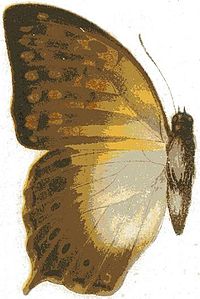Charaxes fulvescens
| Charaxes fulvescens | |
|---|---|

| |
| Charaxes fulvescens, upperside | |
| Scientific classification | |
| Domain: | Eukaryota |
| Kingdom: | Animalia |
| Phylum: | Arthropoda |
| Class: | Insecta |
| Order: | Lepidoptera |
| Family: | Nymphalidae |
| Genus: | Charaxes |
| Species: | C. fulvescens
|
| Binomial name | |
| Charaxes fulvescens | |
| Synonyms | |
| |
Charaxes fulvescens, the forest pearl charaxes, is a butterfly in the family Nymphalidae.
Taxonomy[edit]
Charaxes varanes group. Subgenus Stonehamia (Hadrodontes) The group members are:
- Charaxes varanes
- Charaxes fulvescens very similar to varanes
- Charaxes acuminatus very pointed forewing
- Charaxes balfouri
- Charaxes analava
- Charaxes nicati
- Charaxes bertrami perhaps subspecies of varanes
- Charaxes saperanus
- Charaxes defulvata
Subspecies[edit]
Subspecies include:[2]
- Charaxes fulvescens fulvescens (eastern Nigeria, Cameroon, Gabon, Congo, Central African Republic, Democratic Republic of the Congo)
- Charaxes fulvescens imenti Plantrou, 1989.[3] (central Kenya)
- Charaxes fulvescens marialuisae Canu, 1989 [4](Bioko)
- Charaxes fulvescens monitor Rothschild, 1900 [5] (Central African Republic, southern Sudan, eastern Democratic Republic of the Congo, Uganda, Rwanda, Burundi, western Kenya, north-western Tanzania, north-western Zambia)
- Charaxes fulvescens senegala van Someren, 1975[6] (Senegal, Guinea-Bissau, Guinea, Sierra Leone, Liberia, Ivory Coast, Ghana, Togo, Benin, western Nigeria)
Distribution[edit]

This species is found in Senegal, Guinea-Bissau, Guinea, Sierra Leone, Liberia, Ivory Coast, Ghana, Togo, Benin, Nigeria, Cameroon, Equatorial Guinea, Gabon, the Republic of the Congo, the Central African Republic, the Democratic Republic of the Congo, Sudan, Uganda, Rwanda, Burundi, Kenya, Tanzania and Zambia.[2][7]
Habitat[edit]
These butterflies usually occur in dense evergreen forests at low to moderate altitudes. Occasionally inhabits savanna.[7] In Tanzania it is found at altitudes of 800 to 2,000 metres (2,600 to 6,600 ft) [8]
Description[edit]
Charaxes fulvescens can reach a wingspan of about 46 millimetres (1.8 in).[9] The inner half of the wings is white. Outside the white area of the upperside, the wings are orange to brown, with a pattern of lighter and darker flecks. The underside of the wings mimics a dead leaf. A sepia brown straight line divides the under wing in two areas. The inner area is light beige with several curved, interrupted, grey brown wavy lines. The outer area of the underside of the hindwing has a large eyespot and shows a well developed outer spur. Males and females are similar.[10]
Description in Seitz[edit]
Ch. fulvescens. Distal margin of the forewing in the first three races nearly straight. Forewing above in the basal part light yellow. Hindwing not angled at vein 2. Upper surface of both wings darker in the marginal part than in varanes.- fulvescens Auriv. Both wings beneath light straw-yellow at the base. Sierra Leone to Gaboon. monitor Rothsch. Wings beneath yellow-grey or olive-coloured at the base. Congo to Uganda and German East Africa. - comoranus Auriv.[= Charaxes fulvescens ssp. saperanus Poulton, 1926 = Charaxes saperanus]. Basal area of both wings above uniform light orange- yellow without white; the inner spots in the black distal part of the forewing above much produced transversely; the dark marginal band on the upperside of the hindwing much narrower than in the other races. Comoros: Mayotte. - acuminatus Thurau. [Now species] Forewing with the distal margin deeply excised and long, sharp, falcate apex; the orange or red-brown spots in the black marginal area small or indistinct. German East Africa. [11]
Biology[edit]
The larvae feed on Allophylus species, including A. macrobothrys, A. africanus, A. macrostachys and A. subcoriaceus.[2][7] Notes on the biology of fulvescens are provided by Larsen, T.B. (1991) and (2005) [12][13]
References[edit]
- ^ Aurivillius, [P.O.]C. 1891. Verzeichniss, Einer von Herrn Fritz Theorin aus Gabun und dem Gebeite des Camerunflusses Heimgebrachten Schmetterlings-Sammlung. Entomologisk Tidskrift 12: 193-228.
- ^ a b c d "Charaxes Ochsenheimer, 1816" at Markku Savela's Lepidoptera and Some Other Life Forms
- ^ Plantrou, J. 1989. In: Henning, S.F 1989. The Charaxinae butterflies of Africa 43 (457 pp.). Johannesburg.
- ^ Canu, J.G 1989. In: Henning, 1989. The Charaxinae butterflies of Africa 136 (457 pp.). Johannesburg.
- ^ 1900 Rothschild, 1900 in Rothschild, W., & Jordan, K. 1900. A monograph of Charaxes and the allied prionopterous genera. Novitates Zoologicae 7: [i-iv], 287-524.
- ^ van Someren, V.G.L. 1975. Revisional notes on African Charaxes, Palla and Euxanthe(Lepidoptera: Nymphalidae). Part X. Bulletin of the British Museum of Natural History (Entomology) 32 (3): 65-136.
- ^ a b c "Afrotropical Butterflies: File H - Charaxinae - Tribe Charaxini". Archived from the original on 2013-11-09. Retrieved 2012-05-22.
- ^ Kielland, J. 1990 Butterflies of Tanzania. Hill House, Melbourne and London: 1-363.
- ^ Butterflies of West Africa
- ^ Learn about butterflies.
- ^ Aurivillius, [P.O.]C. 1908-1924. In: Seitz, A. Die Großschmetterlinge der Erde Band 13: Abt. 2, Die exotischen Großschmetterlinge, Die afrikanischen Tagfalter, 1925, 613 Seiten, 80 Tafeln (The Macrolepidoptera of the World 13).Alfred Kernen Verlag, Stuttgart.
 This article incorporates text from this source, which is in the public domain.
This article incorporates text from this source, which is in the public domain.
- ^ Larsen, T.B. 1991 The Butterflies of Kenya and their Natural History. Oxford University Press, Oxford: i-xxii, 1-490.
- ^ Larsen, T.B. 2005 Butterflies of West Africa. Apollo Books, Svendborg, Denmark: 1-595
- Victor Gurney Logan Van Someren (1963). Revisional notes on African Charaxes (Lepidoptera: Nymphalidae). Part I. Bulletin of the British Museum (Natural History) (Entomology) 195-242. [1]
External links[edit]
- Charaxes fulvescens maesseni images at Consortium for the Barcode of Life
- Charaxes fulvescens marialuisae images at BOLD
- Charaxes fulvescens monitor images at BOLD
- Images of C. fulvescens monitor Royal Museum for Central Africa (Albertine Rift Project)
